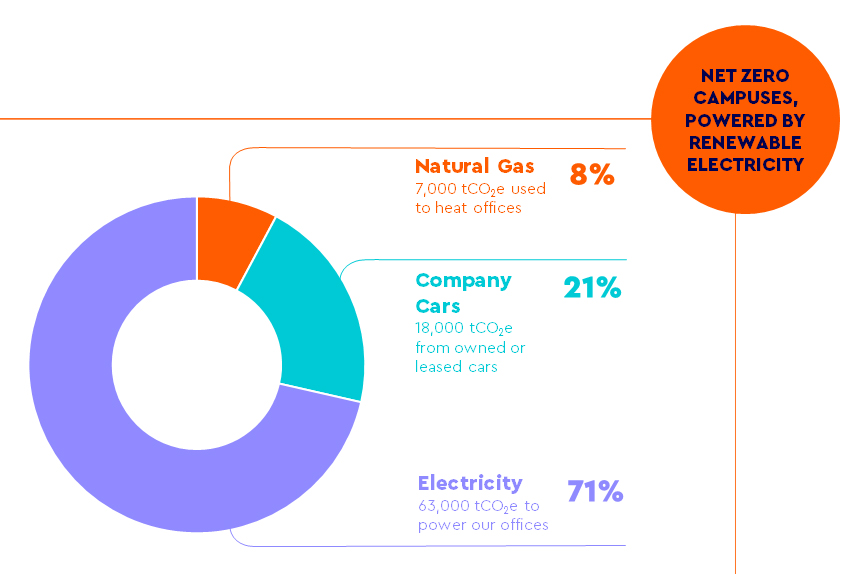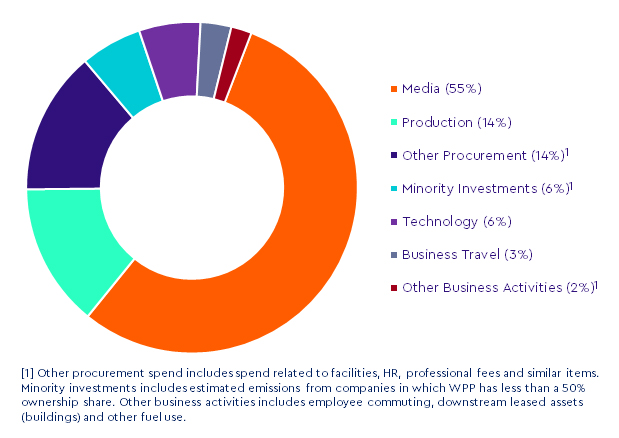What we are doing
We will reduce emissions across our business first, going as far and as quickly as possible. These scope 1 and 2 emissions come from the energy we use, our buildings, and our cars.
Our operational emissions

Our electricity
All our electricity will be renewably sourced by 2025.
In 2020, we announced we would purchase 100% renewable electricity by 2025, which will result in the elimination of all our scope 2 emissions, and reduce our scope 1 and 2 emissions total by 71%. We have already made good headway: globally 65% of the electricity we purchased was renewable in 2020. Across the US, Canada, the UK and the majority of European markets 100% of electricity was from renewable sources.
Our buildings and our cars
As a company that predominantly provides services rather than goods, one of our few significant physical carbon footprints is caused by the emissions from the buildings we occupy. Since 2018, we have been moving our people into our campuses, which are not only world-class workspaces, but are also more environmentally sustainable.
All of the larger buildings we occupy (over 50,000 square feet) are required to be certified to an internationally recognised standard such as the US LEED standard or the UK BREEAM standard. By moving into such buildings, our energy use is cut by around 20% per location.
We are also rethinking how we design our office spaces, using building optimisation technology to reduce energy requirements, and taking into account the potential risks of climate change (for example, increased frequency of extreme weather and climate-related natural disasters) when choosing where to locate a campus.
We’re exploring how to make the shift from a mainly fossil fuel-based car fleet to a more electric or plug-in hybrid fleet.
What we are doing: our supply chain
Our supply chain makes up the most significant part of our total emissions, and just over half (55%) of our scope 3 emissions come from our media investment in advertising.
We will reach net zero on these emissions by 2030.
Our Value Chain Emissions

As part of our scope 3 emissions inventory, which looked at our emissions in 2019, we have highlighted four emissions hotspots for us to address:
Our media spend
With over $60 billion in advertising placed last year, WPP is the world’s largest investor in media advertising. Our media investment forms 55% of our total scope 3 footprint. To reduce emissions, GroupM will focus on: improving data by developing a media channel-level carbon calculator in key markets to understand emissions from each piece of content placed; asking media partners to share carbon data, focusing on top 20 markets and partners first so as not to disadvantage emerging markets or minority media; factoring carbon into investment decisions; and creating education programmes and resources to ensure that we continue to create a healthier, diverse and more trusted media ecosystem.
Our production
The carbon emissions generated by the production of the films and other content we create on behalf of clients are responsible for 14% of our total carbon footprint.
The pandemic has accelerated innovation in virtual production technology and highlighted its ability to reduce the need for expensive and carbon-intensive location shoots. Taking the lessons from this experience, WPP will increase the use of virtual technology, accelerating the shift towards net zero production.
Hogarth, WPP’s creative production business, has pioneered “Sustainably Made”, a unique approach that combines innovative virtual production techniques with industry-leading measurement tools and in-built carbon offset, to allow clients to produce work with a net-zero impact. WPP is also a founding member of AdGreen, a new initiative to remove the negative environmental impacts of production.
Our technology
The technology we use – from data centres to the e-mails we send – generate carbon emissions that make up 6% of our scope 3 footprint. As we increase our use of cloud infrastructure, powered by renewable electricity, we will reduce our energy consumption and our carbon emissions, as well as driving down waste.
Our travel
Business travel generates 3% of our supply chain emissions. Human connection is vital to helping our people and our business thrive, but travel restrictions due to the Covid-19 pandemic have forced us to innovate. We have seen that virtual meetings can help us to stay connected and maintain the highest quality of work. We still believe nothing can replace the value of meeting and connecting in person, but even as travel restrictions lift, we will aim to keep our travel below 2019 levels. We will continue to use digital meetings, and our in-person meetings will be the focused, efficient, and effective.
Improving data quality
In 2020, we began a programme to modernise our procurement ecosystem and infrastructure, and to optimise how we buy. We've been working to standardise our processes and systems, so that by the end of 2022 we’ll be able to use our spend analytics tool across all markets. This change will mean we’ll have better data on our suppliers, allowing us to work with those who meet our emissions standards. We will also be better able to work with our small and medium suppliers to set emission reduction targets and strategies, that will contribute to our reduction as a whole.
Definitions:
|
RE100: WPP is a signatory to RE100, a global initiative bringing together the world's most influential businesses committed to 100% renewable electricity. Ad Green: In 2020, WPP became a founding partner of AdGreen, an initiative to unite the advertising industry to eliminate the negative environmental impacts of production. Launched in the UK through the Advertising Association, but with global ambition, AdGreen provides free training, a renewable energy buy-in scheme and practical resources to enable the industry, wherever the activity is, to act for a sustainable future. In 2021 it will launch a carbon calculator to help production teams identify the activities with the biggest impact. |
